Exploring Cathedral Geodes: Formation and Value
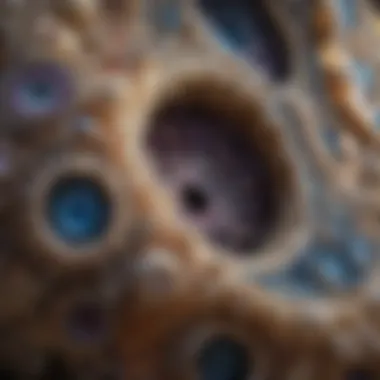
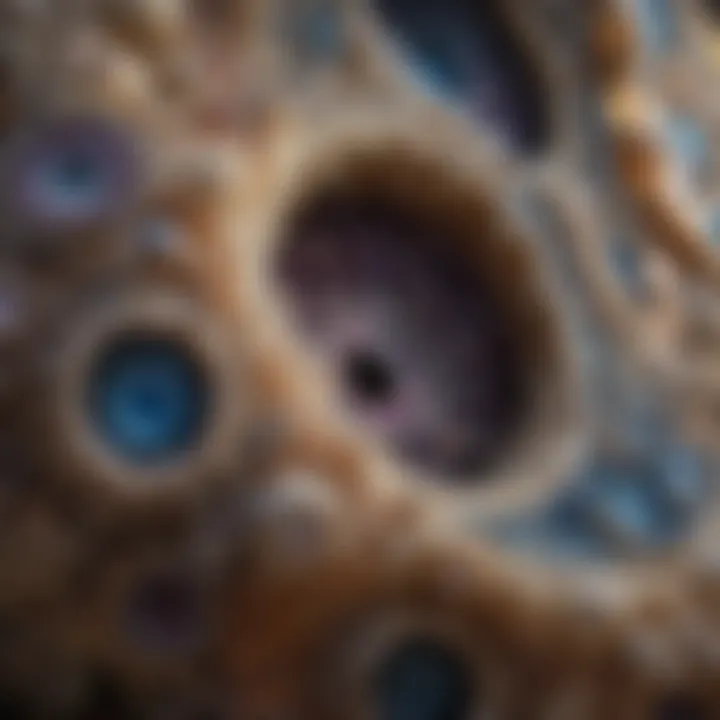
Intro
Cathedral geodes have a unique charm that draws in both collectors and newcomers alike. These geological marvels present a picture that is stunning and intricate, showcasing nature’s artistry carved over millennia. Mainly found in volcanic and sedimentary deposits, they eventually become captivating treasures for those who appreciate the beauty of the Earth’s processes. But how do these wondrous formations begin their journey? What makes them valued in the hands of collectors?
This article aims to shine a light on cathedral geodes, exploring not only their geological formation but also their aesthetic significance and role within the collectible market. We will dive deep into the various characteristics that set them apart, explain the methodology behind valuing these natural wonders, and offer insight into proper care practices for maintaining their stunning appearance. Whether you are a seasoned geologist or a passionate hobbyist, there’s something here for everyone eager to learn more about these mesmerizing geological formations.
Featured Collectible of the Month
Overview
This month's spotlight features the amethyst cathedral geode, a remarkable example of nature's creativity. These colossal structures can reach heights of several feet and feature stunning purple quartz crystals that glitter with a radiance hard to match. The captivating hues of purple, ranging from deep violet to lighter lilac, offer a delightful visual feast that many collectors yearn to acquire. Their striking appearance isn't the only attraction; they also hold fascinating geological stories within, waiting to be uncovered by any who dare venture into their depths.
Historical Significance
Historically, amethyst has been prized for its beauty and believed metaphysical properties. Ancient cultures often considered it a symbol of balance and calmness, attributing powers that ward off negative energies. For many centuries, it has adorned jewelry and served as a vital component in spiritual practices. Collectors recognize not just the aesthetic aspects of cathedral geodes but also their historical context. Understanding their lineage and significance can elevate the way one views these formations and influence their desirability in the market.
Identification Techniques
Identifying cathedral geodes can be an engaging process, one that gives a sense of ownership and expertise to any collector. Here are some crucial aspects to consider:
Visual Characteristics
- Crystal Clarity: A high-quality geode should boast clear and well-formed crystals. Imperfections or cloudiness often indicate lower value.
- Color Variation: Different types of geodes may display varying hues. For instance, the classic amethyst offers shades of purple, while citrine geodes present a golden glow.
- Internal Structure: Observing the internal formation—such as drusy patterns or the shape of the crystals—can reveal much about a geode's origin and true value.
Resources for Identification
For those aiming to refine their identifying skills, several resources are invaluable:
- Books: Exploring literature on mineralogy and geology often reveals key indicators for identifying different types of geodes.
- Online Communities: Joining platforms such as reddit.com or engaging in relevant Facebook groups can provide real-time tips and expert opinions.
- Local Clubs: Many areas have rock and mineral clubs. Connecting with fellow enthusiasts can lead to hands-on learning and invaluable experience.
"The more you understand the origins and characteristics of these formations, the better equipped you'll be when you walk into a mineral shop or enter a rock show."
In summary, cathedral geodes are more than just rocks; they are pieces of history and geological artistry. Understanding their formation and significance not only enriches the collecting experience but also allows for greater appreciation. Exploring these enchanting formations brings new dimensions to your collection, glimmering not just with physical beauty but also with stories waiting to be told.
Next, we will discuss methods for valuating these natural treasures, delving into what makes them sought after in the worldwide market.
Prelude to Cathedral Geodes
Cathedral geodes, with their captivating beauty and intriguing characteristics, stand as one of nature's remarkable creations. They encapsulate a rich tapestry of geological history and serve as a compelling subject in both scientific and hobbyist circles. In this exploration, we will delineate the essence of cathedral geodes, emphasizing their formation, significance, and appeal to collectors and scholars alike.
Defining Cathedral Geodes
At its core, a cathedral geode is an underground hollow rock formation, typically composed of volcanic or sedimentary material, that has formed over eons. Inside these intricate structures, one often finds a dazzling array of crystals deposited in various shapes and sizes. The name "cathedral" evokes a sense of grandeur, akin to the soaring arches and vibrant stained glass of cathedrals themselves. With these formations, the interplay of light against the mineral surfaces can be quite hypnotic.
Geodes can come in a variety of shapes and forms; however, cathedral geodes are particularly noted for their multiple cavities and towering crystal spires that resemble a natural cathedral's architecture. The vibrant colors often seen in quartz, amethyst, or calcite crystals create a spectacle that captures the imagination, making these geological formations highly sought after in the realm of collecting.
Significance in Geological Studies
The study of cathedral geodes offers insights that extend beyond mere aesthetic appreciation. From a geological perspective, the understanding of these formations aids in unraveling the intricate histories of the earth's crust. They serve as geological records, providing clues about past volcanic activity, mineral deposition processes, and the conditions that favored such exquisite crystal growth.
"Cathedral geodes let us peek into the past, giving us a window into Earth’s dynamic processes."
Here's how cathedral geodes contribute to geological studies:
- Environmental Indicators: Their presence can signal the historical conditions of volcanic activity in a region, providing context for current geological mapping.
- Mineral Behavior: Analyzing the types of crystals formed within a geode opens a door to understanding mineral reactions, saturation levels, and temperature fluctuations during formation.
- Ecological Footprints: The location and composition can offer insights into the ecological history of the area, suggesting how plant and animal life may have been influenced by geological changes.
As we delve deeper into this article, we will explore not only the geological marvel of cathedral geodes but also their aesthetic qualities, market value, and their role in modern culture. This multifaceted nature makes cathedral geodes a fascinating subject worthy of detailed examination.
Formation of Cathedral Geodes
The formation of cathedral geodes is not just a captivating display of nature's creativity; it’s also a topic that reveals a wealth of geological insights. Understanding how these magnificent structures come into being is essential for anyone interested in geology, mineralogy, or collecting. This section delves into the specific geological conditions and processes that contribute to the formation of cathedral geodes, providing a clearer picture of their charm and value.
Geological Conditions Required
Temperature and Pressure
Temperature and pressure form the backbone of the geological conditions necessary for the birth of cathedral geodes. These factors create the right environment for mineral deposition. Through geological time, various combinations of heat and pressure lead to the formation of crystalline structures. High pressure, often found deep within the Earth, coupled with elevated temperatures, can facilitate the slow transformation of mineral-rich fluids into solid formations. The result? Complex and stunningly beautiful geodes.
One of the key characteristics of temperature and pressure is their role in the rate of crystallization. When conditions fluctuate, especially during volcanic activity or tectonic movements, the cooling crystals form intricate patterns that define the unique look of cathedral geodes. This adaptation to the pressures of their environment makes them a fascinating topic for collectors and geologists alike.
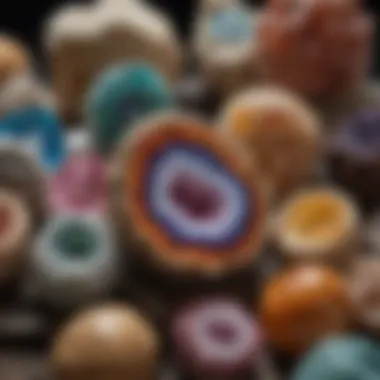
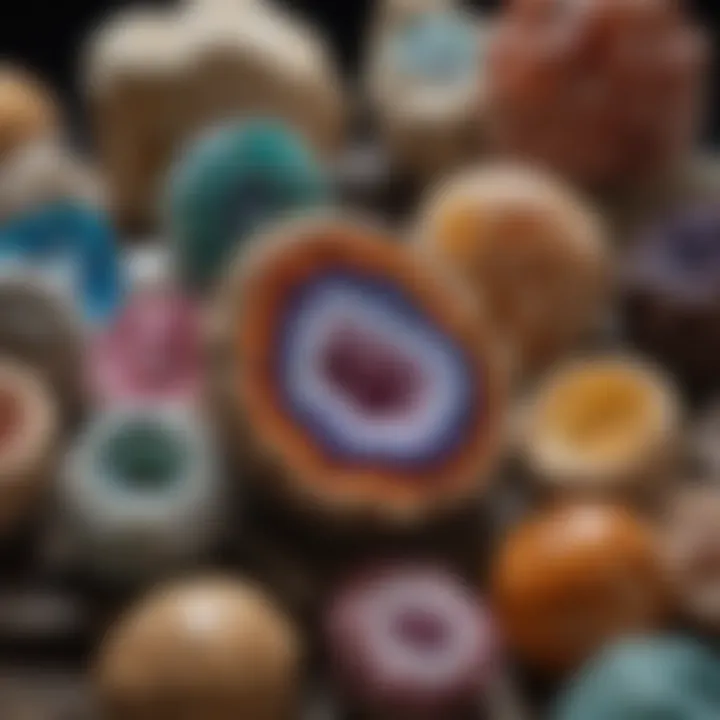
While optimal temperature and pressure lead to exquisite structures, fluctuations can also cause fractures or incomplete formations, which may be viewed as imperfections depending on the collector’s perspective. These variations add layers of story to each geode, marrying beauty with uniqueness.
Mineral Saturation
Mineral saturation refers to the concentration of minerals in solution, leading to the potential for crystallization. For cathedral geodes to form, the mineral-laden solutions must reach a saturation point—this can occur in the presence of water, often infiltrating volcanic rocks or sedimentary deposits. Once saturated, these mineral-rich solutions can precipitate as they evaporate or cool, leading to the formation of specific minerals.
The unique feature of mineral saturation is that it can lead to a wide variety of minerals crystallizing within a single geode. Common ones include quartz, calcite, and amethyst, each providing distinctive characteristics to the geodes. This variety adds to their allure among collectors and showcases the diversity of geological processes.
However, achieving the right level of saturation is a delicate balance. If solutions are overly saturated or undersaturated, it can result in bland or misshapen formations. Therefore, understanding mineral saturation is crucial for both appreciating and identifying authentic cathedral geodes.
Crystallization Process
The crystallization process is where the magic truly happens in the formation of cathedral geodes. This process includes two main stages: initial formation and the subsequent growth of inner linings, both contributing significantly to their eventual appearance.
Initial Formation
The initial formation stage occurs when mineral-rich solutions begin to solidify. An important characteristic of this phase is that it establishes the groundwork for what will later flourish inside the geode. During this stage, gases within the cavity create pressure while also providing the necessary minerals that will crystallize. This combination gives rise to the eventual cavity that makes cathedral geodes so famous.
The unique feature of this initial phase is its unpredictability. The conditions surrounding the formation can drastically change due to geological events, which often leads to fascinating results, like the intricate designs that emerge in the crystal structures. This very unpredictability makes initial formation both a challenge and an excitement for collectors who value the nuances of natural creation.
Inner Lining Growth
The inner lining growth phase occurs after the initial formation, as crystals expand and fill the geode's cavity. This phase is pivotal in the overall aesthetic of cathedral geodes, as it results in the mesmerizing layers of crystals that mirror a cathedral's stained glass. The growth rate can vary significantly, shaped by the availability of minerals and the environmental conditions.
The key characteristic here is the pace at which crystals grow. Slower growth leads to larger, well-formed crystals, while faster growth can yield numerous smaller crystals that create a different visual effect. Collectors often find themselves drawn to particular formations based on these characteristics, each one a snapshot of the conditions at the time of growth.
However, the challenges include environmental factors that can stifle this growth, leading to fewer deposits or less visually appealing formations. Understanding this aspect provides insight into why some geodes are valued more highly than others by collectors.
"Each cathedral geode tells a story, encapsulating precious moments of geological history through beauty."
To sum up, the formation of cathedral geodes is a complex interplay of geological forces. Understanding temperature, pressure, and mineral saturation gives context to their stunning beauty. Likewise, the crystallization process further enriches their allure, blending nature's artistry with the science of geology.
Aesthetic Qualities of Cathedral Geodes
When it comes to cathedral geodes, their aesthetic qualities are not just superficial attributes; they hold deeper significance that resonates with collectors, artists, and geologists alike. The inviting nature of these geological wonders lies in their stunning formations, unique color palettes, and diverse shapes, each contributing to their charm and allure. Understanding these aesthetic elements is key for anyone looking to appreciate the beauty and value of cathedral geodes.
Visual Appeal and Characteristics
Color Variations
Color variations in cathedral geodes are one of the first things that catch the eye. These geodes can exhibit a wide spectrum of hues, ranging from gentle pastel shades to vibrant jewel tones. One key characteristic is the presence of quartz crystals, which can reflect and refract light in ways that enhance these colors dramatically. This variety makes them a popular choice among collectors, as different colors can symbolize various qualities—like trust, creativity, or tranquility.
The unique feature of any particular color variation is how the mineral content influences the hue. For instance, the presence of iron can yield warm reds and oranges, while manganese may introduce purples and deep blacks. This diversity offers an advantage—the ability to select a geode that resonates personally or complements a specific decor theme. On the downside, the more unusual color variations may come at a higher price, making them less accessible to all collectors.
Size and Shape Differences
Size and shape differences add another layer to the appeal of cathedral geodes. From small, palm-sized treasures to massive specimens that require a dedicated display space, the size can dictate both placement and the attention a piece garners. A crucial characteristic is that larger geodes often have more intricate structures and more extensive crystalline growth, which can be mesmerizing to observe.
Furthermore, the unique shapes can mimic natural forms or be irregular, enhancing their artistic value. For example, some cathedral geodes are dome-shaped, while others may have elongated forms resulting from uneven mineral growth. These variations can reflect the natural processes of creation, telling a story of their geological history. However, larger geodes can also pose storage challenges, and their weight might restrict where they can be displayed.
Uses in Art and Decor
The captivating aesthetic qualities of cathedral geodes have found their way into various forms of art and decor. Artists might incorporate these stunning geodes into sculptures or use slices of geodes in artistic designs to create a pop of color or texture. In home decor, they serve not only as eye-catching centerpieces but also as conversation starters among guests.
Many collectors appreciate how these geodes can bridge the gap between natural art and functionality. Cast in settings that allow light to shine through their crystalline interiors, they can create magical shadows and reflections in any environment.
The use of cathedral geodes continues to evolve, presenting fresh opportunities for innovative design while respecting their natural origins. Their integration into human creativity underscores the timeless beauty of nature, making cathedral geodes more than just geological formations; they are genuine treasures that enrich both our living spaces and our experiences.
Collecting Cathedral Geodes
Collecting cathedral geodes is more than just a hobby; it’s a pursuit that taps into the very heart of geological beauty and scientific intrigue. For rock and fossil collectors, these stunning structures offer a tangible connection to Earth’s history while also providing joy and satisfaction with each unique find. This section explores several important elements of cathedral geode collecting, including their market value, rarity, and the practicalities involved in identifying authentic specimens.
Market Value and Rarity
The market for cathedral geodes can be quite vibrant and dynamic. Understanding the factors that influence their value is crucial for collectors aiming to invest wisely. A variety of aspects come into play, including the size of the geode, its internal mineral formations, and overall aesthetic appeal.
- Rarity: Cathedral geodes, especially those with unique crystal formations or vibrant colors, are often considered more valuable due to their scarcity. For instance, a larger geode with rare minerals is bound to fetch a higher price than more common ones.
- Market Trends: Seasonal fluctuations can affect market value, and understanding these trends can help collectors make informed decisions. For example, certain times of year may see more buying activity at mineral shows or online auctions.
As collectors dive deeper into the realm of cathedral geodes, keeping an eye on these factors can significantly benefit their collections and investments.
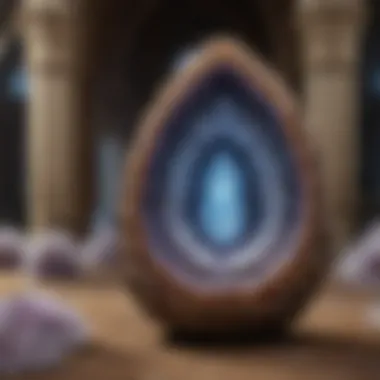
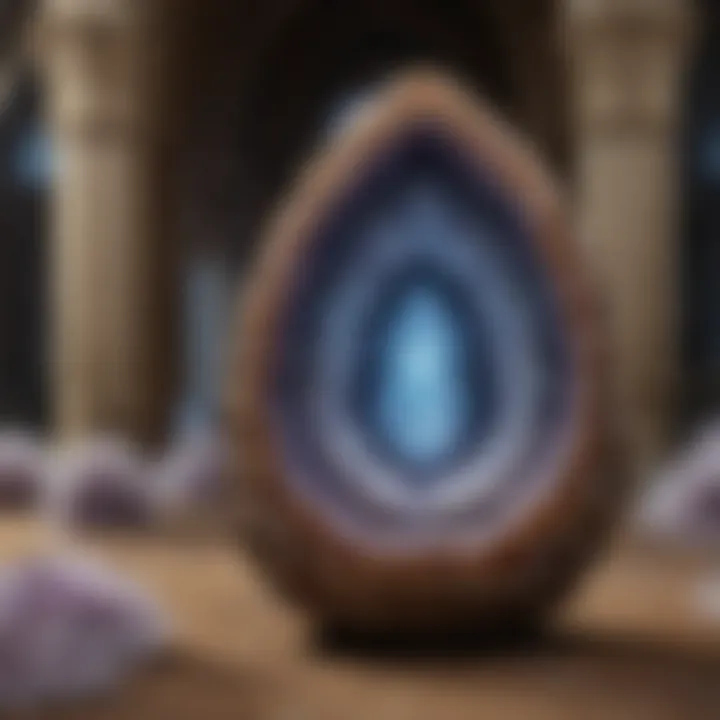
Identifying Authentic Specimens
When it comes to cathedral geodes, distinguishing the genuine articles from fakes or artificially enhanced specimens is paramount. Knowledge and keen observation skills become essential tools for collectors aiming to build a reputable collection.
Physical Examination
One of the most effective methods for identifying authentic cathedral geodes involves a thorough physical examination. This process helps determine the quality and integrity of a specimen.
Key characteristics to focus on during a physical examination include:
- Surface Texture: Authentic geodes often have a rough, natural texture. In contrast, fakes might display overly smooth or glossy finishes.
- Weight: A genuine geode will feel heavier due to the crystals and minerals contained within. A lighter specimen may indicate hollow or improperly formed structures.
The benefit of this approach lies in its accessibility; collectors can examine specimens in person, allowing for immediate assessment. Despite its advantages, it’s worth noting that some variations in physical appearance can arise due to environmental factors, which may complicate assessments.
Test Methods
To further confirm authenticity, various test methods can be utilized, each lending credibility to the collector's knowledge base.
- Acid Test: A small drop of hydrochloric acid can help identify certain minerals present inside the geode. If it fizzles, it’s quite a clear indicator of calcite — a common presence in authentic specimens.
- X-Ray Analysis: Advanced testing techniques (though less accessible to all collectors) can offer detailed insights into the mineral composition and internal structures, assuring authenticity.
These methods provide both certainty and a deeper understanding of each specimen, aiding in the development of a truly impressive collection. While these tests may require some investment in tools or outsourced services, the clarity they provide is invaluable.
"The journey of collecting cathedral geodes is as rewarding as the final destination. Each specimen tells a story that speaks to the magnificence of nature."
In summary, whether focusing on market trends or authentic specimen identification, collectors of cathedral geodes must invest in their knowledge and skills. Building a collection that stands the test of time requires both passion and a commitment to understanding these unique formations.
Caring for Cathedral Geodes
Caring for cathedral geodes is not just a matter of aesthetics; preserving these natural wonders ensures their beauty lasts for generations. For both collectors and enthusiasts, taking care of these geological formations is crucial. The key aspects include understanding the proper cleaning methods and storage requirements, which can enhance their display and longevity. Let’s delve into these components in more detail, as they are fundamental for maintaining the integrity of these striking specimens.
Cleaning Techniques
When it comes to cleaning cathedral geodes, there are a few cardinal rules to follow. First and foremost, it’s essential to avoid harsh chemicals. They can break down the natural minerals or alter their colors, leading to unwanted damage.
- Gentle Scrubbing: Use a soft brush, like a paintbrush or toothbrush, to remove dust and debris. It’s best to do this over a cloth to catch any loose particles and prevent them from scratching the surface.
- Soaking: For deeper cleaning, consider a soak in lukewarm, soapy water. However, make sure to rinse thoroughly and dry immediately. Prolonged exposure to water can lead to issues with some minerals, so it’s vital to strike a balance.
- Natural Methods: For stubborn stains, a paste made of baking soda and water can be applied with care. This approach allows you to clean without using abrasive materials which may scratch the geode’s surface.
By employing these cleaning techniques, enthusiasts can maintain their geodes in peak condition, showcasing their beauty while ensuring that the structural integrity remains intact.
"Cleaning and caring for your cathedral geodes is like tending to a garden; a little effort goes a long way in preserving their natural essence."
Storage Recommendations
Proper storage practices are equally important when it comes to caring for cathedral geodes. Poor storage can lead to physical damage or environmental degradation. Here are several guidelines to consider:
- Display with Care: If you display your geodes, make sure they are secure and unlikely to be knocked over. Using display cases can be beneficial to protect them from dust and accidental bumps.
- Temperature and Humidity Control: Ideally, cathedral geodes should be kept in a stable environment where temperature and humidity levels do not fluctuate drastically. Extreme conditions can create stress on the minerals, leading to chips or cracks.
- Cushioning: When storing, use soft padding like felt or foam to limit movement. This will help prevent scratches and breaks.
- Away from Sunlight: Long exposure to direct sunlight can fade the rich colors of the geodes. Therefore, consider a cool, dark location for storage.
By following these storage recommendations, collectors can ensure the beauty and integrity of their cathedral geodes are preserved for years to come. They will continue to be not just mere collectibles but intricate pieces of natural history.
Scientific Perspectives on Geodes
Understanding cathedral geodes from a scientific angle provides a treasure trove of insights into their origins and significance. Not only do these geological formations reveal a narrative of our earth's history, but they also inform collectors about the integrity and value of the specimens they pursue. Examining geodes through the lens of mineralogy and environmental impacts enriches the dialogue surrounding these natural wonders.
Mineralogy and Composition
Common Minerals Found
Among the most common minerals found in cathedral geodes are quartz, calcite, and sometimes even amethyst. Quartz is the star of the show in this mineralogy, owing to its chemical structure and everyday accessibility. With its pronounced hardness and light refractivity, quartz effectively captivates collectors and geologists alike.
One of the main advantages of quartz in cathedral geodes is its ability to reflect light beautifully, enhancing the overall aesthetic appeal of a specimen. This quality alone makes it a desirable choice for not just collection but also for decorative purposes in homes and offices.
In contrast, calcite brings its own flair. This mineral can exhibit several colors, such as white, blue, or gold, depending on the presence of impurities. It naturally forms in smooth crystal layers that contribute a unique texture to cathedral geodes. However, calcite can sometimes be problematic as it is more susceptible to environmental weathering compared to quartz, raising concerns for long-term preservation.
Unique Structures
Diving deeper, unique structures found within cathedral geodes further amplify their scientific allure. Structures like drusy crystals or stalactite formations can be discovered nestled inside these formations. Drusy crystals add an intricate layer of beauty, enhancing the visual texture. These tiny crystal clusters resemble a sparkly blanket fluffed across the geode wall, emitting an entrancing shimmer when light strikes them at the right angle.
These unique structures not only elevate the aesthetic quality but also contribute to their geological story. They tell of diverse environmental conditions and mineral interactions that were present during their formation.
Nevertheless, these unique formations can complicate the assessment process. Collectors need to ensure they grasp the delicate balance between beauty and structural integrity.
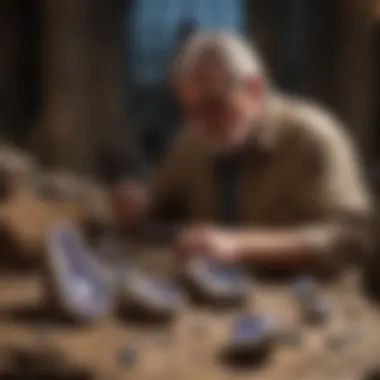
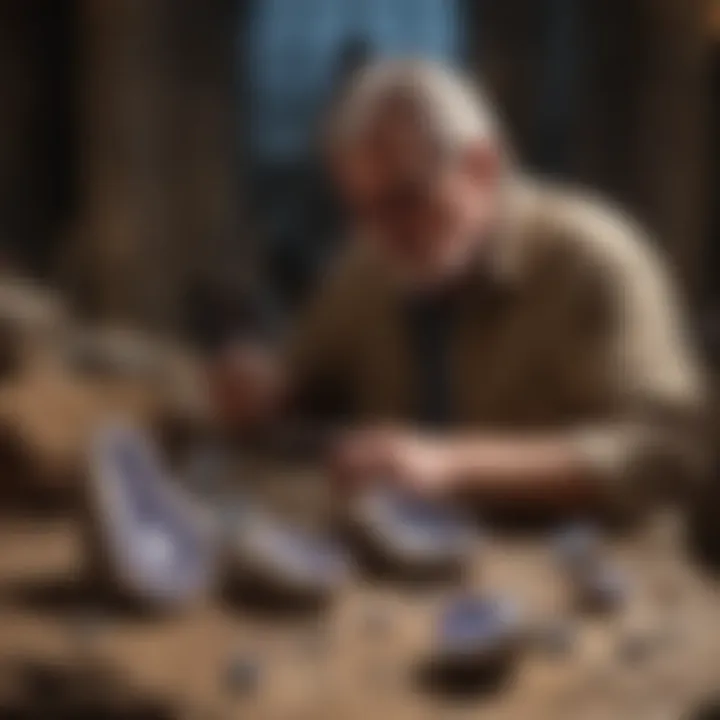
Environmental Implications
Geodes, particularly cathedral geodes, hold more than just beauty—they embody crucial environmental narratives. The environments where they form tell tales of geological history and mineral evolution. As geologists study these formations, they gain insights into narratives of ancient climates, volcanic activity, and even tectonic shifts.
The extraction and collection of geodes can lead to ecological challenges. If overharvesting occurs in fragile geological areas, it may lead to habitat destruction or degradation of the surrounding ecosystem. Thus, mindful collecting practices and respecting nature's balance are essential, ensuring that these formations can be appreciated by future generations.
"The beauty of cathedral geodes isn’t just skin-deep; every layer holds secrets about Earth’s past that science strives to uncover."
Cultural Impact of Cathedral Geodes
The cultural significance of cathedral geodes is as multifaceted as the structures themselves. These geological wonders are not merely dynamic formations of quartz and other minerals; they embody a rich tapestry of stories, beliefs, and practices that have evolved over millennia. From ancient civilizations to contemporary artists, cathedral geodes have played a role that transcends their physical beauty. Their presence in various cultures is marked by reverence and ritual, hinting at a broader appreciation for the natural world.
Historical Significance
Throughout history, these extraordinary minerals have sparked fascination, setting the stage for folklore and myths. Various ancient societies, including the Egyptians and Aztecs, viewed crystals and geodes as powerful sources of energy and healing. It was commonly believed that these formations could harness cosmic forces, offering protection and blessings to those who possessed them.
They were often integrated into religious practices, used in temples and places of worship to invoke spiritual energies. For instance, cathedral geodes occasionally served as focal points in rituals, symbolizing a connection between Earth and the cosmos. The elaborate patterns and colors found within these structures were interpreted as manifestations of the divine, influencing many art forms of the time.
In addition to their spiritual implications, cathedral geodes have played a role in trade and commerce. Regions rich in these formations saw the rise of trade routes, with people journeying to acquire them for both aesthetic and symbolic purposes. The historical narrative surrounding cathedral geodes is not just about appreciation, but also about the vibrant economies they stimulated, contributing to humanity's connection with nature.
Modern Symbolism
In contemporary society, cathedral geodes have managed to carve out a niche that extends beyond their geological properties. Today, they are seen as symbols of harmony, balance, and inner peace. Many individuals believe that possessing a cathedral geode fosters a sense of tranquility, making them popular among wellness and mindfulness practitioners.
Moreover, in an age where climate change and environmental degradation are pressing concerns, cathedral geodes represent a reminder of nature's artistry. Their formations encourage a sense of wonder about the Earth's processes, inspiring people to appreciate and preserve the natural world. To many, collecting cathedral geodes is not only a hobby; it becomes a form of stewardship.
In art and design, these geodes continue to inspire creativity, with artists often incorporating their beauty into sculptures, jewelry, and home decor. The luxury market has also taken notice, as these geodes find their way into high-end designs, further elevating their status as symbols of sophistication and elegance. The cultural impact is profound, spanning from ancient practices to modern aesthetics.
"In the heart of a cathedral geode lies the essence of time, history, and nature's boundless creativity. These formations connect us, not just to the Earth, but to each other, intertwining our stories in a mosaic of existence."
Challenges in Collecting and Market Trends
Collecting cathedral geodes is more than just a hobby for many enthusiasts; it often becomes a passion that intertwines with the broader tapestry of geology and art. However, as alluring as they may be, the journey of sourcing and understanding these stunning natural formations is peppered with certain challenges that every collector should be ready for. This section not only outlines the durability and preservation concerns involved in collecting but also uncovers emerging market trends that can affect collectors and sellers alike.
Durability and Preservation Concerns
The allure of cathedral geodes typically revolves around their stunning beauty and the uniqueness of each piece. However, their fragility often presents a significant challenge. Geodes, particularly those that are larger in size, can be surprisingly vulnerable to physical damage. A minor bump or drop could lead to noticeable chips or fractures, detracting from their aesthetic value significantly.
Preservation Tips:
- Storing Carefully: Keep them in a place where they won’t be jostled. Many collectors use soft-lined cases to cushion their treasures.
- Environmental Factors: Humidity can pose a threat. Excess moisture may cause mineral degradation. Conversely, keeping them in overly dry conditions can lead to cracking.
- Cleaning Methods: A soft brush and gentle soap is often enough. Avoid harsh chemicals that could damage the delicate surface of the geode.
By paying close attention to these aspects, collectors can better ensure that their cathedral geodes maintain their beauty over the years.
Emerging Trends in the Market
The market for cathedral geodes is evolving, influenced by various factors ranging from aesthetic trends to environmental considerations. Collectors are now becoming more discerning, seeking unique pieces that tell a story rather than simply filling a display case.
Some of the recent trends include:
- Sustainable Sourcing: With an increasing awareness about environmental concerns, collectors are now favoring geodes that are sourced responsibly. Sustainability is attracting the attention of conscientious collectors who want to ensure their hobby doesn’t contribute to ecological degradation.
- Artistic Collaborations: Artists are using cathedral geodes in modern art installations, often merging geology with contemporary artistic expressions. This has opened up avenues for collectors to invest in pieces that hold both geological and artistic value.
- Social Media Influence: Platforms like Instagram and Facebook have revolutionized the market. Collectors are now more connected than ever, sharing their finds and learning from each other. This community aspect has created a vibrant marketplace where savvy collectors can buy, sell, or even trade.
The market dynamics surrounding cathedral geodes are ever-changing. As trends evolve, they reshape the strategies collectors use to curate their collections. By staying abreast of these trends, collectors not only enrich their knowledge but bolster their chances of making informed purchasing decisions.
"Buying cathedral geodes is not just about the minerals but also about understanding their journey to your collection."
In summary, while collecting cathedral geodes can be fraught with certain challenges regarding durability and shifts in market trends, being well-informed and proactive can lead the way to a more fulfilling experience. As the world of geode collecting continues to spin, one can expect new challenges and opportunities to emerge, making it an exciting field for both new and seasoned collectors.
End and Future Directions
In drawing our exploration of cathedral geodes to a close, it's vital to reflect on the myriad aspects we’ve discussed. Throughout this article, we have delved into their unique formation processes, aesthetic qualities, and their significance in the collector's market. The fascinating journey of cathedral geodes, marked by their intricate beauty and geological narrative, serves not only as an appreciation of nature’s artistry but also provides a vital connection to our earth’s geological history.
Summary of Key Points
To encapsulate the essential takeaways:
- Formation: Cathedral geodes are born from specific geological conditions, encompassing the right temperature and pressure accompanied by mineral saturation. The growth of crystals within these formations takes considerable time, ultimately leading to visually stunning structures.
- Aesthetic Value: The colors and forms of cathedral geodes can range significantly, appealing to both collectors and artists alike.
- Market Dynamics: Understanding the rarity and the market value of cathedral geodes can guide collectors in making informed investments.
- Care and Maintenance: Proper cleaning and storage practices are crucial for maintaining the beauty and integrity of these geological treasures.
- Cultural Significance: Cathedral geodes represent not just natural beauty, but also reflect historical and modern societal themes, evoking curiosity across ages.
This summary illustrates how cathedral geodes are more than mere decorative objects; they serve as a lens through which we can explore geological, artistic, and cultural dimensions of our world.
Encouraging Further Exploration
As we finalize our discussion on cathedral geodes, consider this a launchpad for further inquiry. Whether you are a seasoned collector or someone dipping their toes into the realm of geology, the world of cathedral geodes is rich for exploration. Here are a few paths to consider:
- Seek Local Geodes: Investigate your local area for potential sites where you might find cathedral geodes. This hands-on experience enriches your understanding and appreciation of these formations.
- Join collector communities: Engaging with groups on platforms such as Reddit can provide insights from fellow enthusiasts, sharing tips and knowledge which could enhance your collecting experience.
- Educational Resources: Websites like Wikipedia and Britannica offer vast information on geological principles that underpin the formation of geodes.
- Workshops and Exhibitions: Attending workshops or exhibitions can allow you to interact with experts, broaden your perspective, and even discover rare specimens.
In essence, deepening your knowledge and involvement with cathedral geodes not only fosters your appreciation for these geological phenomena but also connects you with a vibrant community of fellow collectors and enthusiasts, navigating the continuous journey of discovery.



